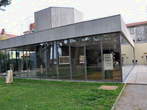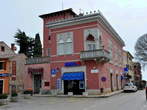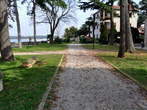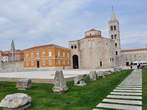Novigrad and its surroundings are renowned for numerous natural and cultural attractions that draw both local and international visitors. The most notable landmarks include the town of Novigrad itself, the picturesque Mirna River Valley, and the Mramornica Cave.
Novigrad is a small coastal town in Istria, situated on the western coast of Croatia along the Adriatic Sea. It is a popular destination due to its historical heritage, charming streets, and inviting beaches. The town boasts a rich historical past reflected in its cultural legacy and numerous attractions. Among the most significant are the town walls with towers and former main city gates, the freestanding bell tower, the parish church of St. Pelagius and St. Maximilian, the Lapidarium Museum, the Rigo Gallery housed in the ground floor of the historic Rigo family palace, and the Austro-Hungarian Navy Museum Gallerion. The bell tower is the most recognizable symbol of the local heritage, constructed in 1883 as a replica of St. Mark’s Bell Tower in Venice, Italy. The parish church of St. Pelagius and St. Maximimilian underwent extensive renovations in 1408, 1580, 1746, and 1775, with its current neoclassical facade dating back to 1935. The church’s most significant feature is its early Romanesque crypt, one of the few of its kind in Croatia. The Lapidarium Museum holds one of the most important collections of its kind in the country, consisting mainly of architectural elements from the parish church.
The old town center was once entirely enclosed by imposing walls, of which only fragments remain today. A well-preserved quadrangular tower near the city gates serves as a reminder of its medieval fortifications, which are believed to have been built on much older, ancient foundations. Novigrad also features picturesque parks, including Giovanni Rainis Park, Irma Bencic Park, and the Novigrad Diocese Park with a sarcophagus. The town is known for its well-maintained beaches, such as Maestral Beach, Laguna Beach, Mareda Beach, Sirena Beach, Karpinjan Beach, Pineta Beach, Rivarela Beach, and the town beach.
The Mramornica Cave, located in Stancija Druskovic near Brtonigla, is one of the largest caves in Istria and a true underground gem. It is named after its striking interior, where light reflecting off the damp walls creates a marble-like effect. Speleologists consider its interior one of the most beautiful and expansive subterranean spaces in Istria. Guided tours of the cave last about thirty minutes. The cave consists of a single chamber, approximately 50 meters wide and 90 meters long, with an entrance depth of 10 meters and a maximum depth of 20 meters. The highest point inside reaches 5 meters, and the cave maintains a constant temperature of 14 degrees Celsius. The chamber is adorned with stalactites and stalagmites in various colors, some reaching up to 13 meters in height and 10 meters in width. The cave’s pathways are well-maintained and secured, allowing visitors to admire otherwise inaccessible sections, which add to its mysterious allure.
The Mirna River Valley is among the most beautiful natural areas in Istria. The Mirna River, stretching 53 kilometers, originates near the town of Hum and meanders through a charming landscape, passing medieval settlements such as Buzet, Motovun, Oprtalj, and Grožnjan. South of Novigrad, it flows into the Adriatic Sea at the Bay of Tar, also known as Luka Mirna. Along its course, the river traverses diverse karst landscapes, including a winding gorge near Istarske Toplice, and lush forested areas, notably the Motovun Forest, valued for its natural beauty and rich ecosystem. The region is home to a variety of plant and animal species, particularly the downy oak, under which prized truffles grow. The Mirna River supports numerous fish and bird species, attracting nature enthusiasts. In addition to its stunning scenery, the area offers numerous outdoor activities, such as hiking, cycling, and water sports, allowing visitors to immerse themselves in the serene and unspoiled beauty of Istria.
Among the Mirna’s important tributaries is the Butoniga Stream, which flows into the artificial Butoniga Lake, known for its reservoir and dam. This part of the valley, together with the Motovun Forest and the surrounding vineyards, offers an unforgettable experience for those exploring this unique region of Istria.







 HR-CRO - Croatia
HR-CRO - Croatia




































